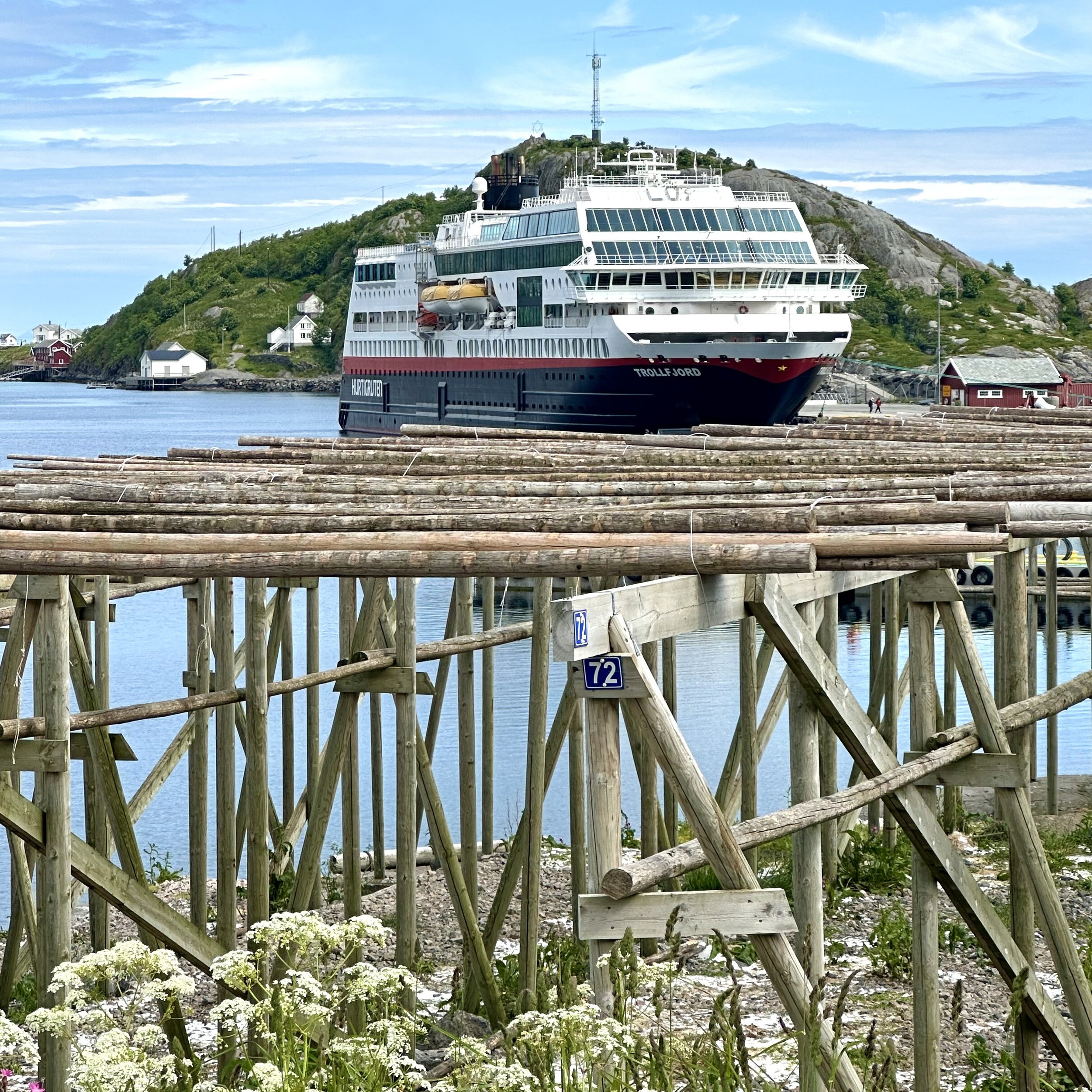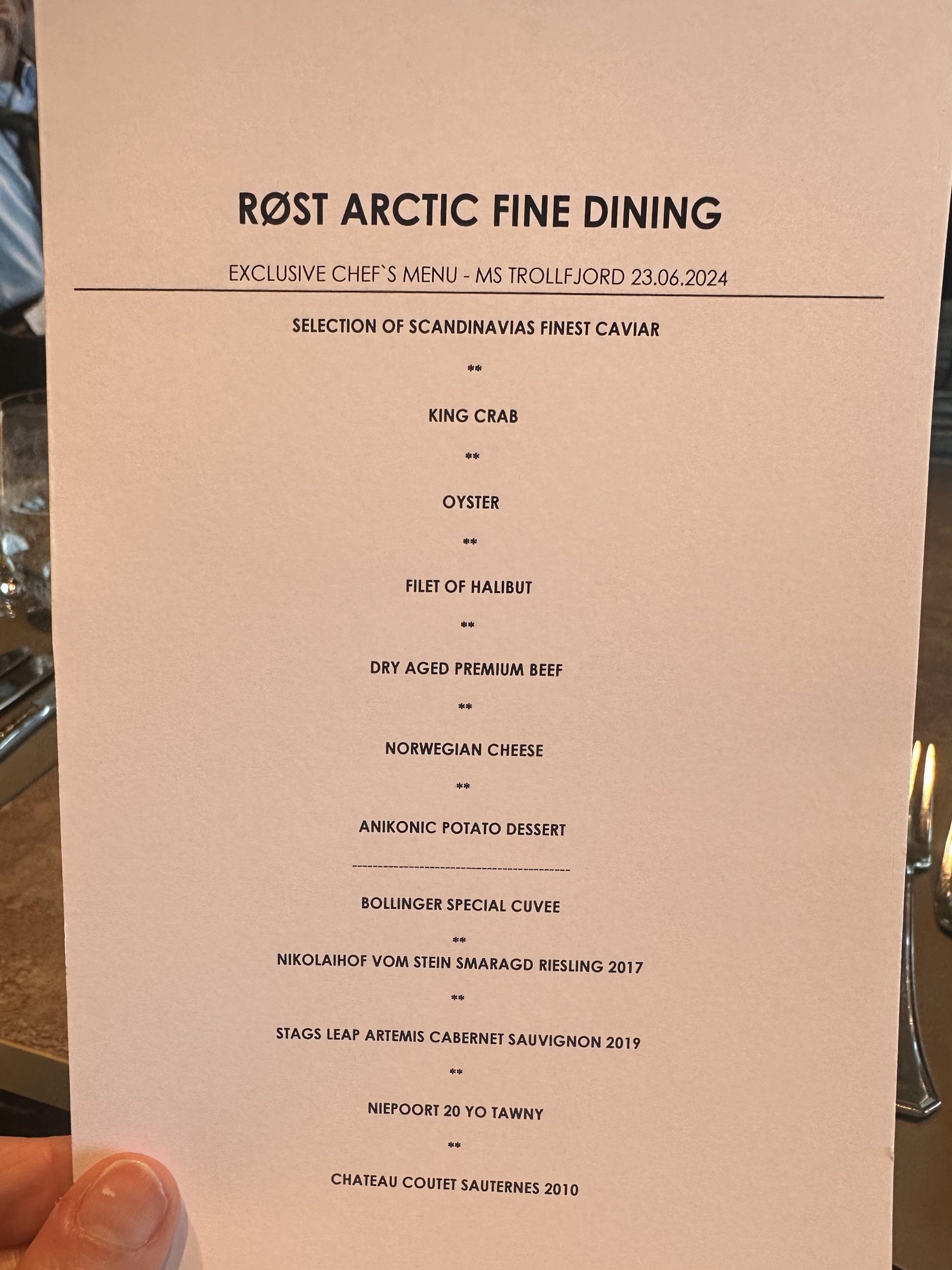Two weeks exploring Norway with Hurtigruten
We were recently invited by Norwegian cruise line Hurtigruten on a two week Svalbard Line voyage on board MS Trollfjord. We had been invited to experience one of their ‘Signature Voyages’ on board the recently refurbished MS Trollfjord. Originally built in 2002 and refurbished in 2023, it is now the main ship in the fleet offering voyages from Bergen up to Svalbard in the Arctic circle and back again. The voyage can be taken as a week long north or southbound voyage or combined to be a two week Bergen round trip cruise, which is what we did, in style! We had been allocated to stay in one of their Expedition Suites in a rather wonderful Grand Suite, which came with its own exclusive perks, but more on that later.
Boarding the MS Trollford in Bergen has to be one of the most laid back embarkations we’ve ever had. The Hurtigruten terminal building is large and modern with a smooth check in process including a relaxing lounge for guests to wait in until the ship is ready to receive them. The safety briefing takes place in the terminal building so once on board gets can simply relax and explore the ship.
Being suite guests we had priority embarkation and were literally the first passengers to board the ship, entering on deck 6 midship by the circular main atrium full height staircase with a glass topped roof and wall mural giving it a light and lofty feeling.
We had been told to make our way up to the Epsolom Lounge, a quiet little lounge area on the port side of deck 8, and one of the many serene little nooks and crannies we would find to relax in over the coming two weeks. But for a couple of hours after boarding it was reserved for suite guests to relax with a welcome glass of champagne while the lovely shop manager helped us to fit our complimentary suite guest clothes haul consisting of a Hurtigruten Collection waterproof jacket, a supersoft merino wool sweater and a choice of woollen beanie hat. What a fun way to start cruise.
Clothes haul completed we were ushered next door to the fine dining Røst restaurant. As suite guests we could take breakfast, lunch and dinner here if we choose to. Located on deck 8, Røst has magnificent views out to sea and with its open kitchen and talented chefs it serves, as we were about to find out, some of the best cuisine at sea. Erik, the restaurant manager introduced himself and asked if we had any food intolerances or preferences, especially important here as the meals tend to be a set menu, three courses at lunchtime and five in the evening, with the chefs varying the menu depending upon the ingredients that have picked up at the various stops along the way. We picked our dinner table for the voyage and sat down to enjoy our first 3 course lunch, served by the magnificent Anna and Robin, who we would get to know very well over the course of our voyage. Not forgetting of course, the incredibly knowledgeable Oscar, Røst’s sommelier, responsible for choosing the perfect wine to match each course of food. Little did we know what gastronomic delights we would be savouring in the next fourteen days but we can honestly day that it was like dining in a Michelin star restaurant twice a day every day for fourteen days. We’ve never eaten so well or tried so many varied and exquisite wines - though we have to say the chicken heart starter we had for lunch one day may have been a step too far for us, even though it was cooked to perfection. Thankfully chef made up for this by serving the most incredible smoked char dish for main course that day!
With our room being ready at 2pm, we finished our lunch and thought we would go and check out our suite, which was conveniently located just down the corridor on deck 8. Our suite, 819, was located at the aft of the ship and easily recognisable from the outside of the ship because of the feature bay window which juts out from the side of the ship. The suite itself was very large with a separate living and sleeping area, both of which had a large TV on the wall, not that we ever turned them on choosing instead to enjoy the views from this fabulous bay window offering 180 degree views. With MS Trollfjord mostly sailing in colder climates, we found the bay window much more useful than a balcony would have been, even though we had glorious weather we didn’t miss a balcony at all, this bay window was a much more useable and inviting space to relax in.
Settled into our suite, it was time for sailaway on the top deck with champagne for all guests from the bar located up on deck 9 and Norwegian flags available to wave as we set sail from a very sunny Bergen. No sooner was sailaway over than it was time for the Welcome talk in the Lecture hall located at the front of the ship on deck 5. We headed down there for the half hour welcome outlining the ship and voyage as well as an introduction to the knowledgable coastal team who we would get to know well over the next two weeks and were a wealth of useful information!
The coastal team (think shore excursions team) who were in charge of all of the excursions, held a ‘daily meeting’ outlining the port of call and activities for the next day and generally answered any queries you might have about the itinerary. The daily meetings were always held in four different languages, Norwegian, English, German and French with four different times for each so you didn’t have to sit through all of the translations. These were also available to watch live or later on the cabin TVs. One of the other things we loved was the ability to turn the loudspeaker function on on your cabin telephones so that any announcements that were made came through automatically on your phones speaker. So often we find ourselves running to the corridor in our robes to try to catch an announcement, we loved that we didn’t have to do this, and of course you can turn this feature off if you don’t want it - such a simple but clever idea!
Before we knew it our first evening was upon us so we thought we would check out the 1893 bar for pre-dinner drinks. This beautifully light and airy double height space is the beating heart of the ship when it’s at sea, with its 270 degree sea views, comfortable chairs, self service hots drinks station and central bar it has everything you need, including a daily afternoon tea offering a buffet of fruit and cakes. The bar is open every day from noon until late. Nico, the bar manager was very proud of his signature cocktails and would make sure to present each one we tried with an explanation of what was in it. As suite guests the cocktail menu drinks were included in our fare but there were also a good range of wines, beers and soft drinks for all guests to enjoy. Pre-dinner drinks here, looking out at the Norwegian coastline and listening to Tammy, the onboard entertainer, playing the piano and singing in the background as we sailed to our next destination, quickly become a highlight of every night.
Our first stop of the voyage was the pretty town of Åndalsnes. Åndalsnes is a picturesque town located in the Rauma Municipality, known for its stunning natural beauty, with dramatic mountains and fjords surrounding it. With a population of approximately 2,400 residents the town's economy is largely driven by tourism, thanks largely to the opportunity for outdoor activities like hiking, climbing, and skiing. We only had a few hours to explore the town and with nothing concrete planned for our visit there, we decided to take a little walk up the mountain. We made it over half way up the mountain before deciding to turn around and make our way back down to the ship again to make sure we were back on board for our lunchtime departure from Andalsnes.
With a full 24 hours of sailing ahead of us we spent most of the afternoon in the 1893 bar, making the most of the stunning views, though we did make sure to go to the first of many cookery demonstrations from the executive chef up on the observation deck. Waking up the next day to a relaxing morning of scenic sailing we spent most of it up on the top decks with our fellow guests and knowledgable Coastal Experience team, enjoying the glorious weather and stunning views, passing two well known Norwegian landmarks including, the Hole in the Rock and the Seven Sisters mountains.
As we had a pre-booked afternoon excursion in Træna we decided to grab a quick lunch in Árran, the all day brasserie style dining venue on deck 5. The restaurant itself is very stylish and comfortable, with a bistro style menu that stays the same throughout the voyage, most of which we tried at some point on our two week voyage. Service here was always attentive and it quickly became our favourite place for lunch, usually followed by a quick stop at the wonderful ship’s shop, full of Norwegian goodies and a perfect place for a post-lunch browse and chat with the lovely shop manager.
Just after lunch we arrived in Træna, one of the oldest fishing communities in Norway, with evidence of a human settlement dating back about 9,000 years, making it one of the earliest inhabited places in Northern Norway. With over 1,000 islands, islets and skerries the area is characterised by rugged terrain, steep cliffs, and stunning seascapes, with the Trænstaven mountain being a notable landmark. It’s current population of around 500 makes it one of Norway's smallest municipalities by population, with its economy primarily based on tourism and fishing. It is most famous for an annual music festival held every July, attracting visitors from all over the world who come to experience music in a unique setting amidst the natural beauty of the islands.
We had booked a Hurtigruten excursion to visit some of the many islands in the vicinity on a local boat, starting with Sanna which has just two full time residents. We didn’t stop there, with the best view of its magnificent rugged landscape best afforded from the boat, but this small inlet is one of the main sites for the music festival which takes place every July. Then we made our way to Selvær, passing Sandøy and Holmen along the way. These are two of Træna’s smallest and most secluded island communities, with only one permanent resident to enjoy the beautiful beaches and old harbours.
Our next stop, Selvær, Træna’s second-biggest island, was a bit of a ride away so we sat back to enjoy the ride. When we arrived we disembarked out little boat and walked to what used to be the primary school until it shut a few years ago. Now used as a village hub, housing a small library, a gym and some multi function rooms, we met up with one of the 50 residents of the island who chatted to us about life on the island and the jobs they do to sustain their livings, such as collecting and cleaning the down of the eider ducks for prized eider down and diving for hand-harvest seaweed. We said our goodbyes to this gorgeous little island, trying hard to imagine the reality of living somewhere this serene and beautiful but so remote.
Back on board MS Trollfjord we set sail for our next destination, eventually crossing into the Arctic Circle, which obviously couldn’t pass unmarked. Though we didn’t get the chance to join in personally with this rather strange ceremony we did enjoy a glass of Norwegian aquavit back in the bar as we sailed towards the second largest glacier in Norway, the Svartisen Glacier, arriving there just before midnight.
With another morning of scenic sailing we had a gathering up on the observation deck as we passed another point of interest, the Lofoten Wall. This range of mountains create the illusion that ships are sailing into a wall, which was pretty much what we were doing as we headed towards the quaint fishing village of Reine nestled at the bottom of one of the mountain ranges. Arriving at lunchtime we had decided to explore this gorgeous fishing village independently. It has a small population of around 300-350 residents with numbers fluctuating with the seasons due to tourism and fishing activities. We had a quick wander around the little village at the port side before embarking on a longer hike around the foot of the mountains and lakes, simply soaking in the stunning scenery.
Having crammed as much as we could into our time ashore, we decided to treat ourselves to a champagne afternoon tea in Røst. Starting with a tea grown just a few kilometres from Reine with flavours of green tea and berry fruits we also accepted a glass of special Havets Bobler to go with our afternoon tea. Havets Bobler literally means “Bubbles from the Sea” and is a distinctive sparkling wine aged beneath the Arctic waters off the coast of Norway and is an innovative project between Hurtigruten and Rathfinny Wine Estate, a family-run vineyard in Sussex, England. Bottles of Rathfinny’s Classic Cuvée 2018 are sealed with wax and submerged approximately 30 meters (about 100 feet) below sea level in Arctic waters. The consistent low temperatures (around 5°C or 41°F), darkness, and increased pressure at this depth create ideal conditions for aging sparkling wine. The underwater aging process is believed to enhance the wine’s structure, resulting in smoother, softer bubbles and more rounded tannins with tasting notes that include refreshing citrus tones and a mineral, oyster-like finish, attributed to the maritime aging environment. The special beverages were accompanied by a large circular wooden board stacked with delectable delights, all created by the amazingly talented pastry (and breakfast) chef, Isabella. Afternoon tea was available a few times throughout our voyage but we only managed to fit it in with our busy schedule twice, though we wish we could have gone every time, it was such a decadent way to spend an hour or so.
We woke the next morning for the first time to slightly sultry skies as we approached Tromsø. Docking up we were delighted to see that the MS Trollfjord was docked right in the heart of the city, rather than on the outskirts where the bigger cruise ships have to dock. We had again booked a Hurtigruten excursion which included a visit to the Polaria museum, the landmark Arctic cathedral and a trip on the gondola experience the best views over Tromsø.
Our excursion finished back at the ship but we had a couple more hours before departure so rather than going back on board we decided to have a wander around the town, ending up in the local brewery to sample some local beer, making it back to the ship just before we set sail for our next destination, Honningsvåg.
Although we had booked another Hurtigruten excursion for our stop in Honningsvåg, we had a few hours to explore the town before boarding the coach for our excursion to the North Cape. We wandered around this very quiet town but the rather dreary weather forced us back to the ship. On our way back to the town centre we spotted a local Christmas shop and even though it was June we couldn’t resist a stop there.
After lunch we set off on our excursion for the hour long coach ride would take us through the Arctic tundra, homeland for the Norwegian reindeer, to the northern most point of mainland Europe, over 71 degrees north and 307 metres above sea level. Arriving at the North Cape we were rather saddened that it was cloaked in fog but rather than let it dampen our spirits we took some photos anyway then headed in to the centre to take a look around. And whilst we were inside the fog lifted and we had just enough time to go back to the cape point to see what the fog had been hiding.
Back at the ship we left mainland Europe for our two day crossing over the Barents Sea to Svalbard. Unfortunately the crossing proved to be less than smooth and though we didn’t particularly enjoy the rough seas, the sea life seemed to be having a whale of a time accompanying the ship through the Barents Sea towards our next point of interest, Bear Island. Bear Island was named by two Dutch explorers in 1596 who upon finding the island encountered a polar bear. It is a remote and rugged island located about halfway between the Norwegian mainland and the Svalbard and is known for its dramatic cliffs, harsh climate, and rich wildlife, including seabird colonies and polar bears. In the past Bear Island was occasionally inhabited, with human activity including whaling, mining, and weather stations. Today, it is largely uninhabited, retaining a small weather station and some seasonal research activity.
Thankfully as the day wore on the sea state calmed and the next day we woke once again to blue skies and smooth seas as we approached the Svalbard archipelago. Little did we know how exciting this day would turn out to be. We started our time in Svalbard with a sailing passed the Russian mining settlement, Barentsburg, the second largest settlement on the island of Spitsbergen. Named after the Dutch explorer Willem Barentsz it was established as a mining community in the early 20th century. Since 1932 it has been operated by the Russian state-owned company Arktikugol and includes a school, a hospital, a hotel, and a consulate, reflecting its self-sufficient community despite its remote location.
With some time to spare before arriving at the Longyearbyen, the main settlement of Spitsbergen, we sailed into a fjord on the lookout for the most famous inhabitants on the island, polar bears. With the crew reporting that they hadn’t seen any so far this year we weren’t all that hopeful. But our fabulous Captain spotted a couple of polar bears on the shoreside in the distance. Regulations dictated that we couldn’t get any closer than we were but we spent the next half an hour or so glued to our binoculars following the bears as they made their way along the shoreline. Eventually we had to say goodbye to these magnificent creatures and make our way to our next port of call, Longyearbyen.
Longyearbyen was founded in 1906 by American entrepreneur John Munro Longyear as a coal mining settlement. Longyearbyen grew rapidly and in 1916 Longyear sold his cola mining company to the Norwegian Spitsbergen Company, marking the start of Norwegian influence and control over the town. Today, Longyearbyen is the northernmost permanently inhabited town in the world, situated at a latitude of 78 degrees north. It boasts a unique polar climate, with long, dark winters and continuous daylight during the summer months. One of the most intriguing aspects of Longyearbyen is its prohibition on burials; the permafrost prevents bodies from decomposing, so those who die in Longyearbyen are typically transported to the mainland for burial, something Hurtigruten helps them with as part of their commitment to transport necessary cargo between the mainland and the islands. Longyearbyen is also known for the Svalbard Global Seed Vault, an important global food security initiative. The vault, built into a mountain, stores seeds from around the world to safeguard against the loss of crops due to natural disasters, war, or other crises. Additionally, Longyearbyen is a hub for scientific research, particularly in fields related to climate change, geology, and Arctic biology. The town’s location and unique environment offer researchers unparalleled opportunities to study the effects of extreme cold and long-term ice coverage.
We had again booked a Hurtigruten excursion in Longyearbyen and were very excited about this one, as we were about to go husky sledging. As soon as we docked we headed ashore and were met by our husky trainer, Rebecca, who drove our small group of fellow intrepid adventurers the 20 minutes drive up to the training station where we donned our protective clothing and headed out into the holding area to meet the very excitable dogs. Having shown them some love we helped the dog handlers to harness them up, six per sled, and set off on our 14km drive. What fun, and such a lovely way to soak in the stunningly barren landscape of the backroads of Longyearbyen.
By the time we got back to the ship after a fabulous few hours with these incredible dogs, it was time to leave Longyearbyen - we wished we’d had a bit more time in this city, with so much to do and see there. But we were heading even further north for the small settlement, Ny-Ålesund, a small research settlement and one of the northernmost permanently inhabited places on Earth, located at a latitude of 78°55′ N. Originally established as a coal mining town in the early 20th century, mining was abandoned after several accidents, including a tragic explosion in 1962. It was later transformed into a hub for Arctic research and monitoring, and is now an international research station, hosting scientists from over 10 countries. Studies there focus on climate change, glaciology, biology, and atmospheric research and it is home to the Zeppelin Observatory, which monitors air quality and greenhouse gases.
Ny-Ålesund is only accessible by boat or small plane, with visitors limited, so as not to interfere with the scientific work and environmental preservation. As such a critical site for understanding climate change and its impact on the Arctic, it’s pristine environment and international cooperation make it a symbol of science-driven efforts to protect and study the planet’s fragile ecosystems. We had to turn off our mobile phones long before we arrived in the region and were not permitted to turn them back on until we were a certain distance out to sea.
Having served as the launch site for several historic Arctic expeditions, including Roald Amundsen’s airship flight to the North Pole in 1926 we were able to walk out to the launch site accompanied by a local on the look out for polar bears. Amundsen launched the airship Norge from this point with the goal to fly over the North Pole and demonstrate the feasibility of airship travel in polar exploration. The airship flew from Ny-Ålesund, across the North Pole, and landed in Teller, Alaska, covering approximately 5,400 kilometres (3,355 miles), marking a significant achievement in Arctic exploration. The expedition solidified Amundsen’s legacy as a pioneering polar explorer and advanced the possibilities of Arctic exploration through innovative technology.
After a rather exciting day visiting one of the most unique and unusual destinations we’ve ever been we didn’t think the day could get much better but it did! We had made a reservation for the special, once per cruise, Executive Chef 7 course tasting dinner. An extra charge event this comes with a pretty hefty cover charge of 1950NKO (about $183 or £145) and has a limited number of places available. With a section of the Røst restaurant reserved for this special meal we took our table along with eight other lucky guests and were poured a glass of Bollinger by Oskar, the sommelier, who warmly welcomed us to this special evening. The dinner started with a special prepared cocktail presented to us by Nicolai from the bar to accompany our glass of Bollinger and the first course, caviar. The caviar course was followed by a deep fried oyster served with a herb mayonnaise which was then followed by a king crab loin with brown butter mayonnaise, served with a pickled celeriac pancake stuffed with crab salad.
While we watched the chefs preparing the next course Oskar served us our next wine, an Austrian white from the Wachua valley, perfectly paired with the lovely halibut dish which followed. Next up was a Cabernet Sauvignon from Napa Valley to accompany our meat course, a deliciously tender piece of premium tomahawk beef, dry aged on board the ship for 6 weeks, simply accompanied by a Norwegian chimichurri. The delicious cheese course was accompanied by a 20 year tawny port followed by a lovely dessert wine to pair with the final course for the evening, the Anikonik potato cake dessert. Three hours of eating and drinking was finished off with another fabulous cocktail creation from Nikolai.
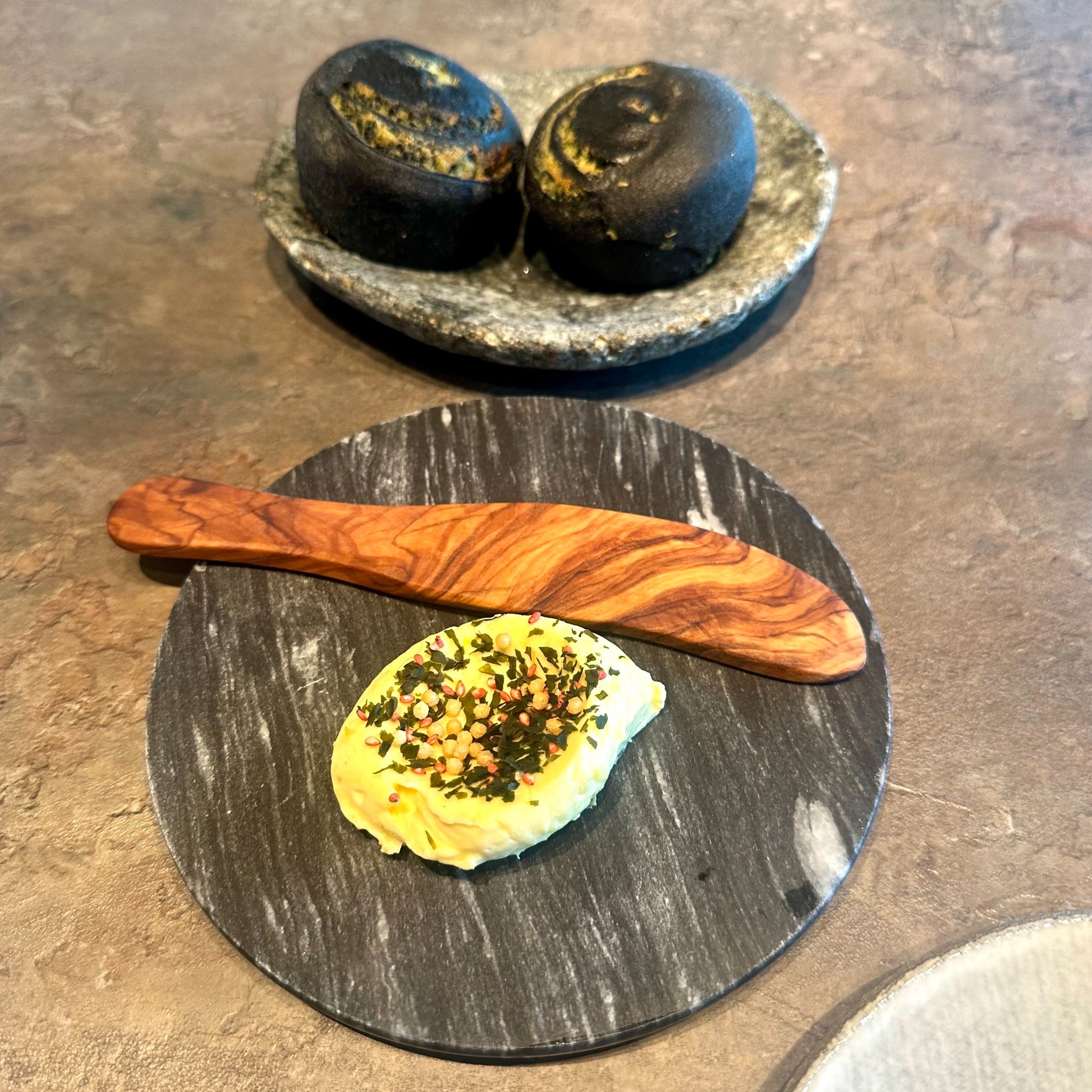


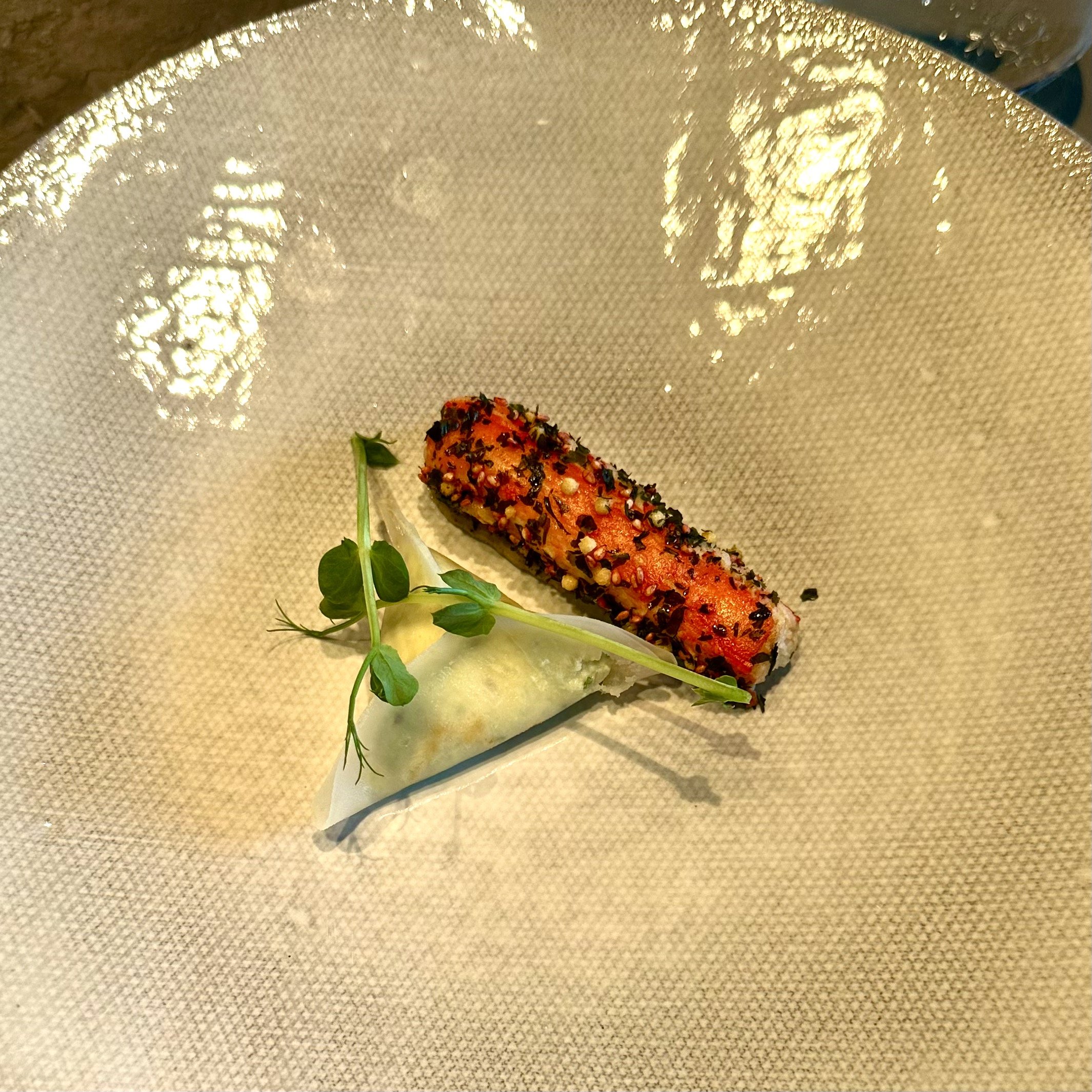
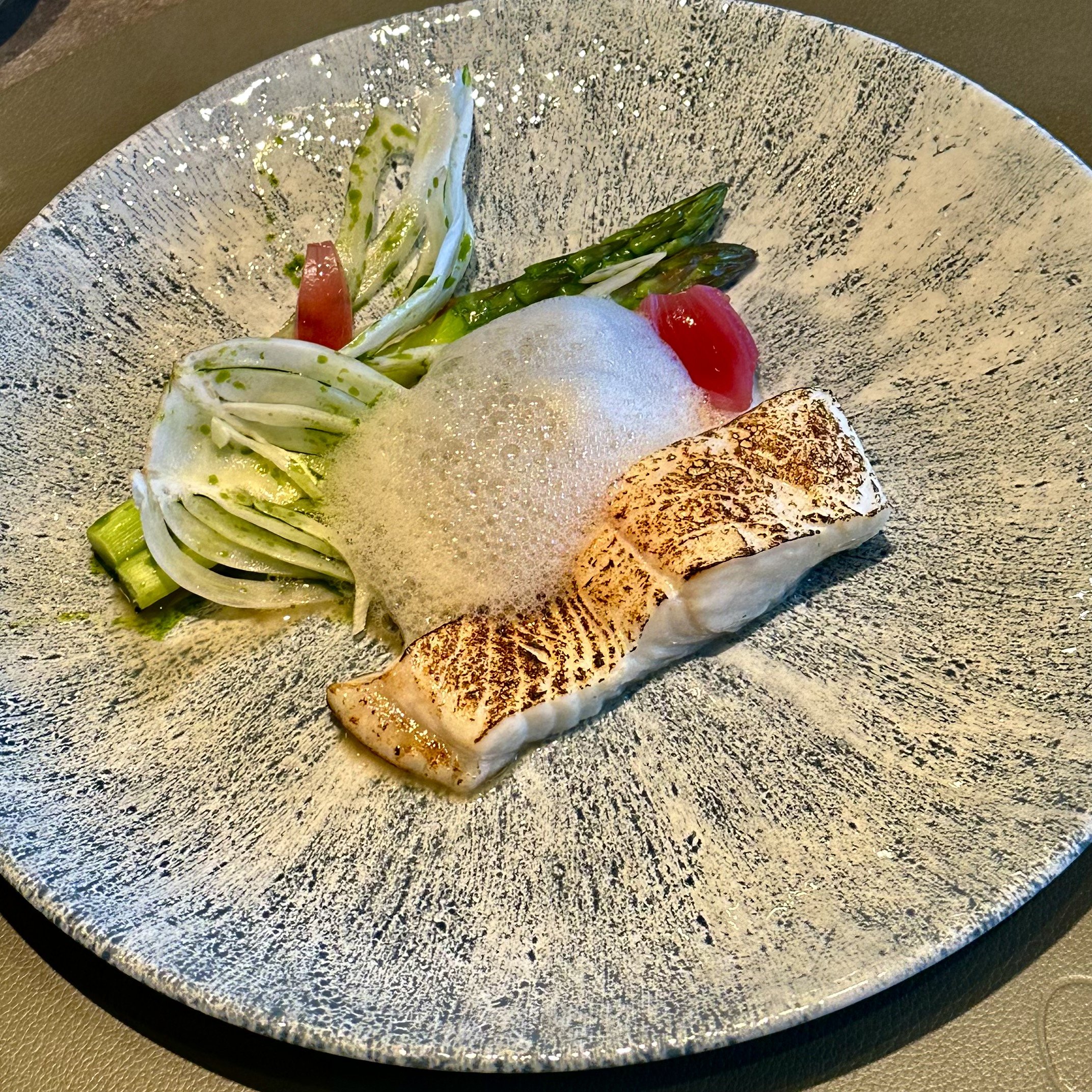
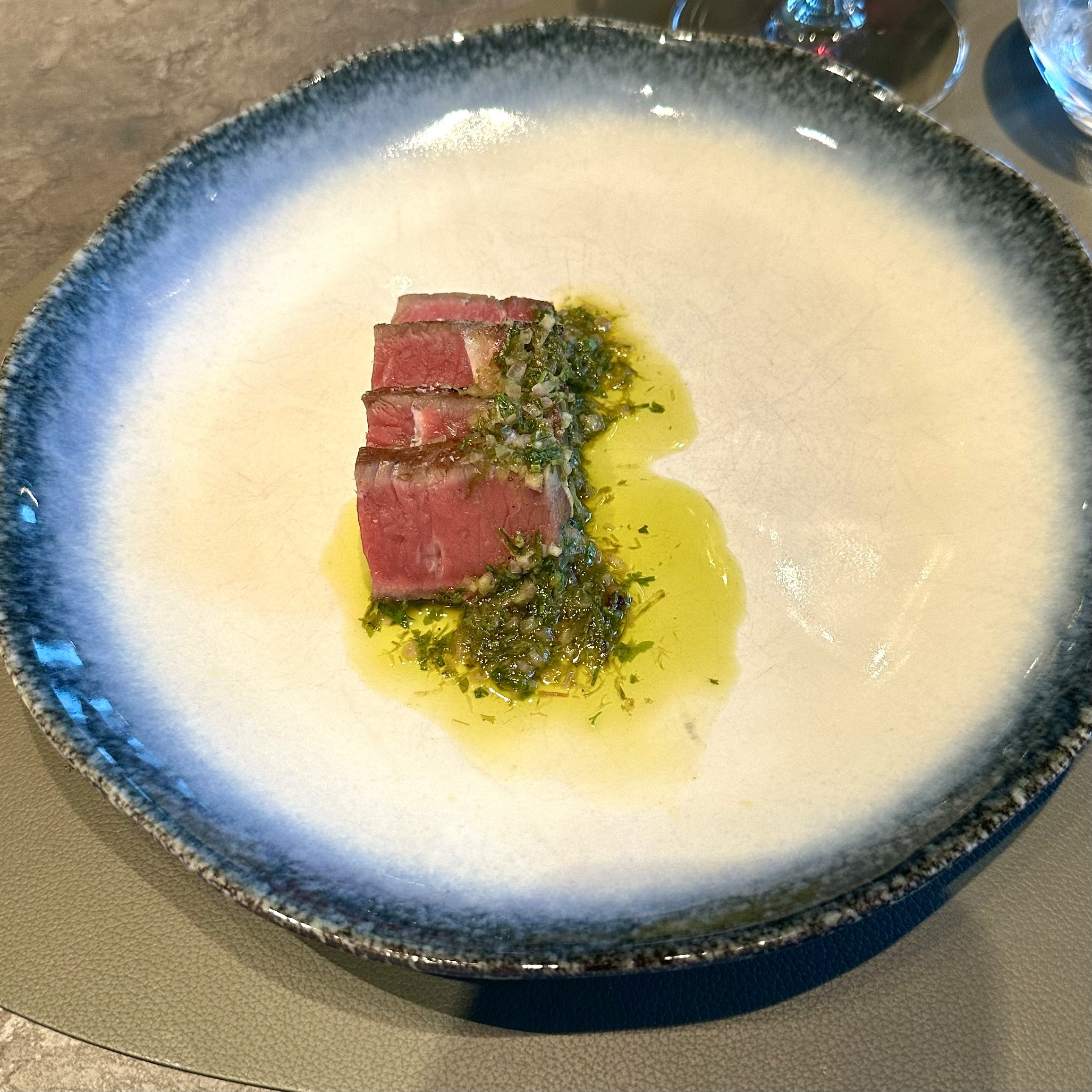
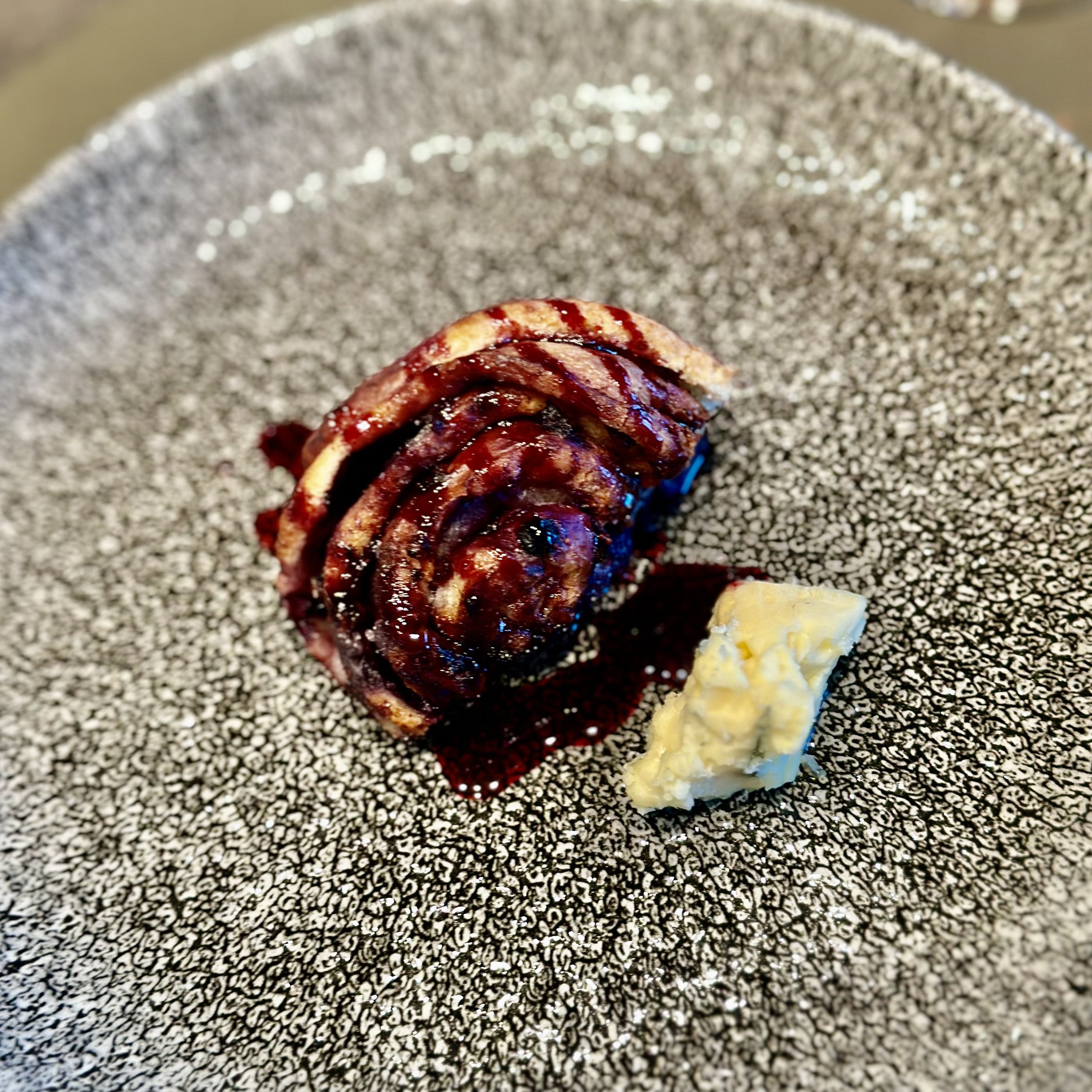

As we enjoyed this delicious meal, MS Trollfjord started our journey back south towards the mainland and our next port of call, the island of Senja, thankfully with much calmer seas than we had on our northbound journey. Senja is Norway’s second-largest island, located in the northern part of the country and is known as the “Fairy Tale Island,” due to its breathtaking landscapes, combining rugged mountains, deep fjords, picturesque fishing villages, and pristine beaches. For this reason we had decided to book a Hurtigruten e-bike excursion to try to cover as much ground as we could in the short time we were there. Unfortunately the weather was again against us, with the rain lashing our faces as we rode across the mountain to see one of the ‘pristine beaches’ which when we got there was shrouded in cloud. Despite the rain we had a brilliant time and we can honestly say that by the time we got back to the ship we were more wet than we have ever been, even with the protection of our fabulous Hurtigruten rain jackets.
Even though the bikes were thankfully, with all of the hills we climbed, electric we had exerted enough energy to have built up a bit of an appetite meaning we enjoyed our dinner more than ever. During our meal the rain finally stopped and as we were staying in Senja until midnight we decided that after dinner we would head out again and use the voucher we had been given by the bike company for a drink in the local pub which was only a minutes walk from the ship. What a way to end a delightful day in this pretty fishing village, especially the wonderful ‘sunset’ at nigh on midnight!
Early the next morning we arrived at Stokmarknes as the sun was rising above the mountains. Stokmarknes is an important stop on most Hurtigruten Norwegian routes as it’s the birthplace of the Hurtigruten coastal express and the fancy new Hurtigruten museum, the Hurtigrutemuseet which celebrates the history of the Hurtigruten (which literally means Coastal Express). The museum features the retired ship MS Finnmarken, which is preserved within the museum. Our brief two hour stop here meant that we just had enough time to tour the museum before we had to leave for our next destination.
With our whistle stop tour of the museum over it was time to leave Storkmarknes and head to our next stop, Svolvær, the capital of the Lofoten islands. But first we had a little detour as our fabulous Captain skilfully navigated us, in quite high winds, down the fjord our ship is named after, the Trollfjord. What an amazing sight and a real privilege to have the opportunity to do this.
Arriving in Svolvær just after lunch we had another Hurtigruten excursion booked, this time kayaking in the sea around Svolvær. We thought that kayaking in Svolvær would offer us an unforgettable way to explore the steep mountains, calm fjords, and vibrant fishing villages that surround this town situated in the heart of the Lofoten archipelago, and we weren’t disappointed. A quick walk along the waterfront took us to the kayak centre where, after a quick briefing we got in our double kayaks. The excursion took us to the foot of the nearby mountain situated on the outskirts of the town, then paddling over to the fishing huts and uninhabited Risøyan islands on the other side of the harbour before returning to the ship. Although the sea was relatively calm the wind and tides limited how far we could go but we really enjoyed another active excursion, seeing the dramatic landscape from a different perspective.
Back on board the MS Trollfjord we set sail from Svolvaer, heading further south and back passed the Seven Sister’s mountain range that we had passed on our northbound journey, as we approached our next port of call, the beautiful city of Brønnøysund. Brønnøysund is famous for being the coastal midway point of Norway, located exactly mid point between the northern and southern most points of the country. Interestingly it’s also home to Norway’s registration centre with many of the residents employed there to register the countries births, deaths and marriages.
One of the things tourist go to when they’re in Brønnøysund is go to see the nearby Torghatten mountain, a unique and iconic mountain famous for its natural hole that runs straight through the mountain, creating one of Norway’s most fascinating geological features. The hole is approximately 160 meters long, 35 meters high, and 20 meters wide and was formed during the last Ice Age, when ice and water eroded the softer parts of the rock, leaving behind the dramatic tunnel. According to Norse mythology, the hole was created by an arrow shot by a troll in a love story gone wrong. When the sun rose, the troll turned to stone, forming the mountain. Though it is possible and popular to hike through the hole itself we decided instead to take a RIB boat ride to see it from the sea which was so calm that once we reached the viewpoint for the hole in the rock our guide simply turned off the boats engines, poured us all a welcome cup of hot coffee and let us all soak up the suns rays, the magnificent views and serenity of the surroundings.
With our RIB boat ride at and end we returned back to the town centre with enough time to do the other things that Brønnøysund is famous for, enjoying fresh strawberries and ice cream, a treat enjoyed by both residents, visitors and the ships crew! Why is it so special - the long summer days and cooler temperatures of Norway’s northern climate result in juicy, sweet strawberries with a rich flavour. These are paired with creamy ice cream with many of the cafes and restaurants in Brønnøysund serving this iconic treat.
And so another fabulous morning in a pretty Norwegian town had come to an end and it was time to set sail again for an afternoon of stunning scenic sailing as we headed even further south towards Ålesund. Arriving early the next day and with only a brief stop in the city we left the ship as soon as it was docked to head on up to the Aksla viewpoint. Though rain threatened the beginning of our walk thankfully it never amounted to anything and we enjoyed the walk up to the view point, making it back to the ship in time for breakfast.
With a few hours of scenic sailing ahead of us we headed up to the top deck as we approached Hjorundfjord, arriving into Sæbo, a beautiful little valley town at the end of the fjord. MS Trollfjord was at anchor in the fjord, the first time we hadn’t been alongside on this cruise, giving us the chance to take a local tender to shore and see the ship docked in the fjord. Sæbø is known for its unspoiled beauty and the towering mountains that rise straight out of the water. We decided to simply enjoy a walk around this pretty town visiting some of the shops and enjoying the views.
What a fabulous final port of call before returning to Bergen where we had to say a fond farewell to Norway and the wonderful team on board the MS Trollfjord. Despite having done three previous Norwegian fjords cruises these two weeks had taken Norwegian cruises to a whole other level, giving us a new appreciation for Norway, its people, its cuisine and of course its stunning coastline. Never had we expected that this cruise would involve so much scenic sailing with the route taking us through so much of Norways inside passages, only going out to open sea when it was completely necessary. Not only were we surprised by the outstanding beauty of Norway but we were complexity taken aback by Hurtigruten cruises, which had exceeded our expectations on every level, from our gorgeously spacious suite, the wonderful all-Scandinavian crew, the exquisite and refined cuisine, wines and bar offerings and the authenticity of everything they offered. There’s no escaping that ‘regular’ cruisers may be disappointed by the lack of traditional entertainment (though we loved Tammy the pianist who played every evening in the bar from 7-11pm), replaced instead with lectures, insights and stunning scenery, or the lack of sunbeds and hot tubs, replaced instead by a rather stark observation deck BUT none of that matters when you’re sipping on a Norwegian beer in the panoramic 1893 bar soaking in the stunning views, the likes of which you will struggle to match anywhere else in the world. Helen even got a warning from her Apple Watch at one point on this cruise because her heart rate had fallen so low her watch was concerned, that’s how relaxed we were!
Thank you to Hurtigruten who hosted us on this two week Svalbard Line cruise in one of their Signature Expedition suites, covering the cost of our cruise and all excursions, excluding air fares and our pre-cruise stay in Bergen, which were paid for by us. Hurtigruten had no editorial control over any of our content, either before, during our after our voyage and have not paid us to promote them or this post.
If you enjoyed this blog why not take a look at some of our other blogs, especially our Rhine River cruise with Glacier Express extension
If you’re interested in booking a cruise like this, please consider contacting Panache Cruises, the leading specialist in Elite Ocean, River, Expedition and Yacht Style cruising. Simply click here or give them a call on the number below and one of their dedicated Cruise Connoisseurs will discuss your perfect cruise. Call this number now - 0161 513 8202 (UK) or 888 894-6153 (US) and don’t forget to mention that we sent you to receive exclusive benefits and invitations.
If you would like to receive notification of any new blog posts, updates of our travels or links to our vlogs we would love for you to sign up to our mail list below. Thank you.























































